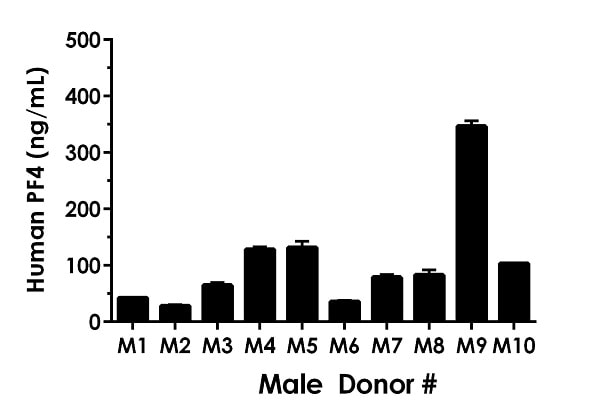Human PF4 ELISA Kit, Fluorescent (ab278096)
Key features and details
- One-wash 90 minute protocol
- Sensitivity: 24.29 pg/ml
- Range: 78.13 pg/ml - 5000 pg/ml
- Sample type: Cell culture media, Cell culture supernatant, Cit plasma, EDTA Plasma, Serum
- Detection method: Fluorescent
- Assay type: Sandwich (quantitative)
- Reacts with: Human
Overview
-
Product name
Human PF4 ELISA Kit, Fluorescent
See all PF4 kits -
Detection method
Fluorescent -
Precision
Intra-assay Sample n Mean SD CV% Overall 8 3.7% Inter-assay Sample n Mean SD CV% Overall 3 3.5% -
Sample type
Cell culture supernatant, Serum, Cell culture media, EDTA Plasma, Cit plasma -
Assay type
Sandwich (quantitative) -
Sensitivity
24.29 pg/ml -
Range
78.13 pg/ml - 5000 pg/ml -
Recovery
Sample specific recovery Sample type Average % Range Cell culture supernatant 108 100% - 115% Serum 93 89% - 99% Cell culture media 97 85% - 90% EDTA Plasma 103 97% - 115% Cit plasma 92 83% - 100% -
Assay time
1h 30m -
Assay duration
One step assay -
Species reactivity
Reacts with: Human -
Product overview
PF4 (CXCL4) in vitro CatchPoint SimpleStep ELISA (Enzyme-Linked Immunosorbent Assay) kit is designed for the quantitative measurement of PF4 (CXCL4) protein in human serum, plasma and cell culture supernatants.
This CatchPoint SimpleStep ELISA kit has been optimized for Molecular Devices Microplate Readers. Click here for a list of recommended Microplate Readers.
If using a Molecular Devices’ plate reader supported by SoftMax® Pro software, a preconfigured protocol for these CatchPoint SimpleStep ELISA Kits is available with all the protocol and analysis settings at www.softmaxpro.org.The CatchPoint SimpleStep ELISA employs an affinity tag labeled capture antibody and a reporter conjugated detector antibody which immunocapture the sample analyte in solution. This entire complex (capture antibody/analyte/detector antibody) is in turn immobilized via immunoaffinity of an anti-tag antibody coating the well. To perform the assay, samples or standards are added to the wells, followed by the antibody mix. After incubation, the wells are washed to remove unbound material. CatchPoint HRP Development Solution containing the Stoplight Red Substrate is added. During incubation, the substrate is catalyzed by HRP generating a fluorescent product. Signal is generated proportionally to the amount of bound analyte and the intensity is measured in a fluorescence plater reader at 530/570/590 nm Excitation/Cutoff/Emission.
-
Notes
Platelet factor-4 (PF4/CXCL4) is a 70-amino acid protein that is released from the alpha-granules of activated platelets whose major physiologic role appears to be inhibiting local antithrombin III activity and promoting coagulation. PF4 has a role in inflammation and wound repair by acting as a strong chemoattractant for neutrophils, monocytes, and fibroblasts.
-
Platform
Pre-coated microplate (12 x 8 well strips)
Properties
-
Storage instructions
Store at +4°C. Please refer to protocols. -
Components 1 x 96 tests 100X Stoplight Red Substrate 1 x 120µl 10X Human PF4 Capture Antibody 1 x 600µl 10X Human PF4 Detector Antibody 1 x 600µl 10X Wash Buffer PT (ab206977) 1 x 20ml 500X Hydrogen Peroxide (H2O2, 3%) 1 x 50µl Antibody Diluent CPI - HAMA Blocker (ab193969) 1 x 6ml Human PF4 Lyophilized Recombinant Protein (ab9562) 2 vials Plate Seals 1 unit Sample Diluent NS (ab193972) 1 x 50ml SimpleStep Pre-Coated Black 96-Well Microplate 1 unit Stoplight Red Substrate Buffer 1 x 12ml -
Research areas
-
Function
Released during platelet aggregation. Neutralizes the anticoagulant effect of heparin because it binds more strongly to heparin than to the chondroitin-4-sulfate chains of the carrier molecule. Chemotactic for neutrophils and monocytes. Inhibits endothelial cell proliferation, the short form is a more potent inhibitor than the longer form. -
Sequence similarities
Belongs to the intercrine alpha (chemokine CxC) family. -
Post-translational
modificationsBinds non-covalently to a proteoglycan molecule. -
Cellular localization
Secreted. - Information by UniProt
-
Alternative names
- C-X-C motif chemokine 4
- Chemokine (C X C motif) ligand 4
- Chemokine (CXC motif) ligand 4
see all -
Database links
- Entrez Gene: 5196 Human
- Omim: 173460 Human
- SwissProt: P02776 Human
- Unigene: 81564 Human
Images
-
-
Raw data generated on SpectraMax M4 Multi-Mode Microplate Reader is shown in the table. Background-subtracted data values (mean +/- SD) are graphed.
-
 Interpolated concentrations of native PF4 in human serum, plasma and cell culture supernatant samples.
Interpolated concentrations of native PF4 in human serum, plasma and cell culture supernatant samples.The concentrations of PF4 were measured in duplicates, interpolated from the PF4 standard curves and corrected for sample dilution. Undiluted samples are as follows: serum 2%, plasma (citrate) 0.5%, and plasma (EDTA) 4%. The interpolated dilution factor corrected values are plotted (mean +/- SD, n=2). The mean PF4 concentration was determined to be 249.53 ng/mL in serum, 622.09 ng/mL in plasma (citrate), and 117.28 ng/mL in plasma (EDTA).
-
The concentrations of PF4 were measured in duplicates, interpolated from the PF4 standard curves and corrected for sample dilution. Undiluted samples are as follows: PBMC cell culture supernatant 12.5%. The interpolated dilution factor corrected values are plotted (mean +/- SD, n=2). The mean PF4 concentration was determined to be 19.25 ng/mL in PBMC cell culture supernatant.
-
Interpolated dilution factor corrected values are plotted (mean +/- SD, n=2). The mean PF4 concentration was determined to be 267.15 ng/mL with a range of 47.05 – 986.18 ng/mL.
-
Interpolated dilution factor corrected values are plotted (mean +/- SD, n=2). The mean PF4 concentration was determined to be 104.38 ng/mL with a range of 27.73 – 353.63 ng/mL.
-
To learn more about the advantages of recombinant antibodies see here.





















